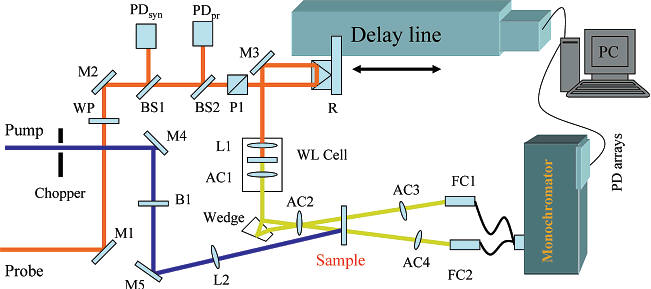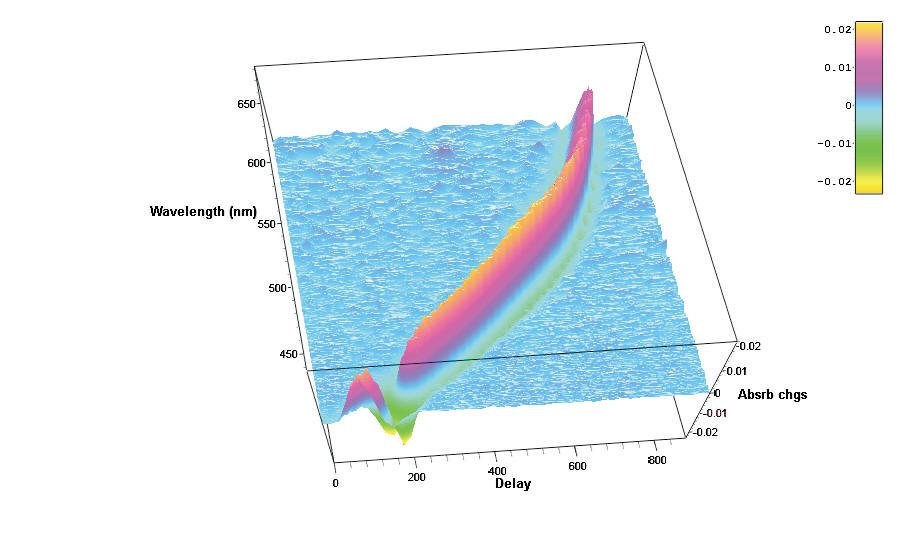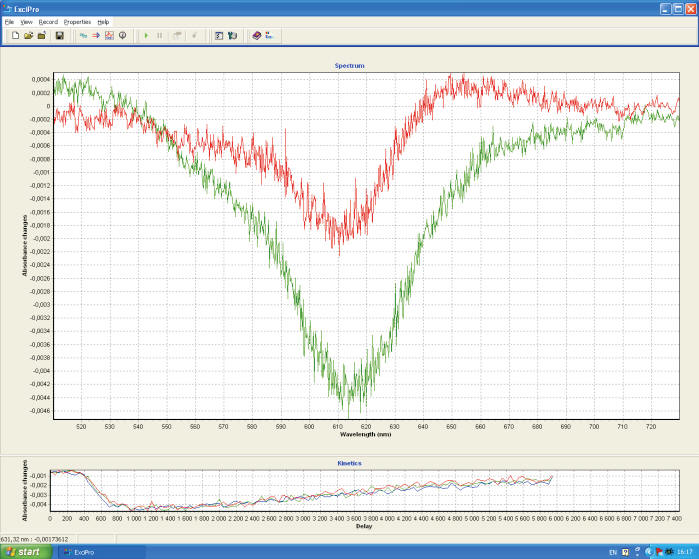
Del Mar Photonics - Hatteras brochure - Request a quote - Custom Femtosecond Transient Absorption Data Acquisition Systems
Relaxation Dynamics of Ruthenium Complexes in Solution, PMMA and TiO2
Films: The Roles of Self-Quenching and Interfacial Electron Transfer
Chih-Wei Chang,† Chung Kuang Chou,† I-Jy Chang,‡ Yuan-Pern Lee,† and Eric
Wei-Guang Diau*,†
Department of Applied Chemistry and Institute of Molecular Science, National
Chiao Tung UniVersity,
No. 1001, Ta Hsueh Road, Hsinchu 30010, Taiwan, and Department of Chemistry,
National Taiwan
Normal UniVersity, No. 88, Sec. 4, Ting-Chow Road, Taipei 11677, Taiwan
The relaxation dynamics of two transition-metal complexes, [Ru(bpy)3]2+ and
[Ru(bpy)3(mcbpy)]2+, in ethanol solution and in poly(methyl methacrylate) (PMMA)
and TiO2 films have been investigated with time-resolved emission and
femtosecond transient absorption spectroscopy. The emission lifetime of a
degassed [Ru(bpy)3]2+ solution in ethanol was determined to be 700 ns; to
describe the self-quenching kinetics due to aggregation, three decay
coefficients, 5.3, 70, and 220 ns, were obtained for the [Ru(bpy)3]2+/PMMA film.
The electron
transfer through space in a [Ru(bpy)3]2+/TiO2 film competed with intrinsic
intersystem crossing ( 100 fs) and vibrational relaxation ( 6 ps) in solid
films. For the [Ru(bpy)2(mcbpy)]2+/TiO2 film, although the relaxation for
electron transfer through bonds was more rapid than electron transfer through
space, both processes occur on similar time scales. Through femtosecond
transient absorption measurements, we provide important dynamical evidence for
the interfacial electron transfer in both forward and backward directions. We
conclude that in dye-sensitized solar-cell applications processes for
interfacial electron transfer are significant not only through bonds but also
through space.
Femtosecond Transient Absorption Measurements. Femtosecond transient
absorption spectra were recorded with a pump-probe spectrometer (sold in
Americas under brand name Hatteras - Del Mar Photonics) in combination with an
ultrafast amplified laser system. The amplified laser pulses were obtained from
a regenerative amplifier (Legend-USP-1KHE, Coherent) seeded with a mode-locked Ti:sapphire laser system (Mira-Seed/ Verdi V5, Coherent) and pumped with a 1-kHz
Nd:YLF laser (Evolution 30, Coherent). The laser pulses are centered at 800 nm
with an average energy 2.5 mJ pulse-1. The FWHM of the amplified pulses ( 60 fs)
was determined by a single-shot autocorrelator (Coherent). The amplified pulse
was equally split to pump two optical parametric amplifiers (OPerA-F, Coherent)
in combination with harmonic generations (SHG, THG, and FHG), sum-frequency
generation (SFG), and difference-frequency generation modules, which provide
tunable femtosecond pulses in the wavelength range 240 nm-10
µm.
Figure 1 shows the optical layout of the femtosecond pump-probe TA spectrometer.
Basically, the dye molecules in an electronic excited-state can be prepared by
an excitation pulse (Pump); the resulting transient species and their relaxation
dynamics can be monitored by a probe pulse (Probe). The polarization of the
excitation pulse was controlled with a Berek compensator (B1), and the pump beam
was focused onto the rotating sample cell containing the solution or thin-film
samples. For single-wavelength kinetic measurements, the probe pulse was
generated with the OPA/wavelength converter; for transient absorption spectral
measurements, the white-light (WL) continuum was produced on focusing the
residual amplified pulse (800 nm) on a continuous water-flow cell (WL cell). To
record transient absorption spectra with and without the excitation pulses, we
used a chopper to modulate the excitation pulse.
E-mail for complete article

Figure 1. Optical layout of the femtosecond transient absorption
spectrometer. M1-M5, gold or aluminum mirrors; BS1 and BS2, beam splitters;
Wedge, wedge prism; B1, Berek compensator; WP, half-wave plate; Pl, polarizer;
L1 and L2, lens; AC1-AC4, achromatic lens; FC1 and FC2,
optical fiber couplers; PD, photodiode; R, retro-reflector. For single
wavelength measurements, the white-light (WL) cell was removed, and both
FC1 and FC2 were replaced with two photodiodes.
 |
Femtosecond Transient Absorption Measurements system
Hatteras. Future nanostructures and biological nanosystems will take advantage not only of the small dimensions of the objects but of the specific way of interaction between nano-objects. The interactions of building blocks within these nanosystems will be studied and optimized on the femtosecond time scale - says Sergey Egorov, President and CEO of Del Mar Photonics, Inc. Thus we put a lot of our efforts and resources into the development of new Ultrafast Dynamics Tools such as our Femtosecond Transient Absorption Measurements system Hatteras. Whether you want to create a new photovoltaic system that will efficiently convert photon energy in charge separation, or build a molecular complex that will dump photon energy into local heat to kill cancer cells, or create a new fluorescent probe for FRET microscopy, understanding of internal dynamics on femtosecond time scale is utterly important and requires advanced measurement techniques. |
More Hatteras customers:
1. National Taiwan University, Taipei, Taiwan (Prof.
Pi-Tai Chou)
2. National Tsing Hua University, Hsinchu, Taiwan (Prof.
I-Chia Chen)
3. Toyota CRDL Inc., Aishi, Japan
4. Tokyo Metropolitan University, Tokyo, Japan
5. Osaka University, Osaka, Japan
6. International Laser Center, Bratislava, Slovak Republic
7. Institute of Physical Biology, Nove Hrady, Czech Republic
8. Institute of Spectroscopy, Troitsk, Russian Federation
9. Nanoparticle Manufacturing
Laboratory, University of Leeds, Leeds, UK - Yasir Khan Technician
y.khan@leeds.ac.uk
10. University of Joensuu, Joensuu, Finland
11. Universidad de Castilla-La Mancha, Toledo, Spain
12. School of Chemistry, North-West University,
South Africa - Christien A Strydom
E-mail us to receive complete contact details of our Hatteras customers
Hatteras Specifications (pdf):
Hatteras femtosecond transient absorption
pump-probe system:
Input requirements: > 0.5 mJ at 800 nm, < 100 fs, 1 kHz
1. All optics and mechanics for pump – probe measurements, assembled on a
breadboard with cover box: femtosecond white light (continuum) generator for
probe and reference pulse formation at 400 – 1600 nm; 2.0 -ns optical delay
line; transmission and reflection configurations; optics for fluorescence
anisotropy measurements; rotating sample cell assembly; holder for solid samples
and thin films; set of selected color and neutral density filters.
2. Multi channel detector head, with two 1024-pixels extra-deep well NMOS linear
image sensors, 200 -1000 nm spectral response (10% of peak), > 5800 dynamic
range, up to 1 kHz readout rep. rate
3. Hatteras 2022i imaging spectrometer, adapted to the detector head and
connected to a computer via serial port:
4. Photodiode for the system synchronization
5. Photodiode for pump power measurements
6. Synchronized chopper
7. Hatteras 3.0 data acquisition, chirp correction, 3D and kinetic analysis
software
Infrared multichannel detector head (option), with two 256-pixels InGaAs linear
image sensors, 100 -1700 nm spectral response (10% of peak), > 5800 dynamic
range, up to 1 kHz readout rep. rate
Standard Hatteras quote based on US
Domestic list price. Add 10% for International quotes.
E-mail us for a custom quote
Main advantages of Hatteras pump-probe (transient absorption) spectrometer:
![]()
1. We use pump-probe configuration, where two signals (probe and reference) are
measured by two linear image sensors. This configuration is very important for
precision optical density changes (ΔOD) measurements, because one can get
results independent on probe beam fluctuations. Calculation of probe to
reference ratio is the key principle of the pump - probe method. To our
knowledge, probe beam only without reference one is used by other pump-probe
systems, and device
sensitivity in this case is seriously limited by probe beam stability.

2. Two linear image sensors of Hatteras are placed in the focal plane of high
quality imaging spectrometer with four-grating turret to provide automatic
grating switching. Two standard gratings are installed to cover 330 nm – 1700 nm
spectral range with 206 nm detection range. A central wavelength of the
detection range is computer controlled. Two other gratings are available
optionally on the customer’s choice and request. To our knowledge, simple
spectrometer, configured for one fixed spectral range and equipped with one
sensor, is used by other pump-probe systems. We use spectrometer specially designed for pump-probe
measurements.
3. Hatteras CDP2022C imaging spectrometer has two outputs. Multichannel detector head is
mounted on the first one, and the second one is for optional single channel
detector head, containing two (probe and reference) photodiodes. This single
channel option is important for high quality transient absorption kinetics
measurements at given wavelength. Because of larger photo detector area and
larger detector dynamic range, single channel system usually gives better ΔOD
sensitivity than multichannel one (both systems use probe and reference beams).
Other pump-probe systems do not offer this option.
4. We offer:
• Si multi channel head (200 nm – 1000 nm),
• InGaAs multi channel head (900 nm – 1700 nm),
• Si single channel detector head (320 nm – 1060 nm, 190 nm – 1100 nm on
request)
• InGaAs single channel head (900 nm – 1700 nm, 900 - 2000 nm on request)
• CdHgTe (1 m - 17 m) single channel head
Hatteras is a modular system. If you order visible multi channel head as a basic
one, in future you can order other heads and connect to your control unit. One
multi channel and two single channel heads can be connected to the control unit
simultaneously.
Other pump-probe systems do not offer these possibilities.
5. Hatteras-T kit of optical and mechanical components is flexible to satisfy
user’s requirements. For example, a configuration with two single channel heads
is used for single scan anisotropy kinetic measurements (both kinetics are recorded
simultaneously for parallel and perpendicular polarization). To our knowledge,
other pump-probe spectrometers do not realize many configurations available in
Hatteras.
6. Hatteras configurations give possibilities to direct probe and reference beams
to the entrance slit of the monochromator fiber coupling or directly
(free-space).
First method is simpler. Second method requires more precise adjustments, but
gives better S/N, especially in UV region. To our knowledge, fiber coupling only is
used by other pump-probe systems.
7. Hatteras offer many sample holder options including specially designed
rotation cell. It gives a
possibility of “pseudo single-shot experiment”, when every pulse at 1 kHz hits a
fresh sample. To our knowledge, only single sample holder such as shaking sample cell only is used by
other pump-probe systems. It
is simplest solution and we used that approach 20 years ago…
8. Linear image sensors with 1024 pixels (sensitive at 200 nm – 1000 nm) are
used in the Hatteras. To our knowledge, other
pump-probe systems use sensor with 512 pixels.
9. Extra-deep well photodiode linear image sensors are used in the
Hatteras. These sensors were specially designed for
photometric applications like transient absorption pump-probe experiments where
very small signal changes should be detected. CCD detectors used in other
pump-probe systems are not photometric devices
and give less S/N.
10. 2. 0 ns delay line with 0.78125 min step is used in the Hatteras. 1.6 ns
delay line with 3.5 fs min step is used in other pump-probe systems.
11. Pump pulse energy is measured for every pulse (special photodiode is used
for this purpose). Pump pulse margins or normalization can be applied for
further S/N improvement.
12. CDP2017 frequency conversion option (optical parametric amplifier with
frequency mixing and second harmonic) was specially designed to make pump beam
easy tunable in 480 nm – 800 nm spectral range. Although one can use other
optical parametric amplifiers, CDP 2017 gives cheaper solution and better
matching with Hatteras.
13. Alternatively, TOPAS from Light Conversion (Lithuania) or OPerA Solo from
Coherent is recommended as a computer controlled OPA operated with
Hatteras ExciPro
software.
14. Our data sheet demonstrates well resolved transient absorption peak of
0.0003 OD and corresponding noise is less than 0.0001 RMS. Although other
pump-probe systems claim 0.0002 OD noise, all available data sheets show one and the same
spectrum where scale for the optical changes is not shown.
15. Hatteras ExciPro software makes user friendly data
acquisition, chirp correction and some procedures for instant data analysis. On
the other hand, obtained 3D spectra can be easy exported to various special data
analysis software like Mathematica, Origin, Femtoscan, or Surface Xplorer.
E-mail us to discuss custom software package.

16. Hatteras optical unit together with the spectrometer is more compact than
other pump-probe systems optical unit, although we use probe – reference scheme, rotating sample
cell, Berek’s wave plate assembly and other components which are not used in
other systems.
18. Hatteras has been designed by ultrafast dynamics veterans in 1999 – 2000 for precision
measurements of small photo induced optical density changes (ΔOD) in wide
spectral range. Using our own many years experience in pump-probe experiments,
as well as experience of leading laboratories, all components were specially
designed, selected, and tested to make state-of-the-art system with best
specifications. Hatteras is first femtosecond transient absorption spectrometer
on the market.

Standard Hatteras quote based on US
Domestic list price. Add 10% for International quotes.
E-mail us for a custom quote
Product Data Sheets
Del Mar Photonics Product brochures - Femtosecond products data sheets (zip file, 4.34 Mbytes) - Del Mar Photonics
Send us a request for standard or custom ultrafast (femtosecond) product
Pulse
strecher/compressor
Avoca SPIDER system
Buccaneer femtosecond
fiber lasers with SHG Second Harmonic Generator
Cannon Ultra-Broadband Light
Source
Cortes Cr:Forsterite
Regenerative Amplifier
Infrared
cross-correlator CCIR-800
Cross-correlator Rincon
Femtosecond Autocorrelator
IRA-3-10
Kirra Faraday Optical Isolators
Mavericks femtosecond
Cr:Forsterite laser
OAFP optical attenuator
Pearls femtosecond fiber laser
(Er-doped fiber, 1530-1565 nm)
Pismo pulse picker
Reef-M femtosecond scanning
autocorrelator for microscopy
Reef-RTD scanning
autocorrelator
Reef-SS single shot
autocorrelator
Femtosecond Second Harmonic Generator
Spectrometer ASP-100M
Spectrometer ASP-150C
Spectrometer ASP-IR
Tamarack and Buccaneer
femtosecond fiber lasers (Er-doped fiber, 1560+/- 10nm)
Teahupoo femtosecond Ti:Sapphire regenerative amplifier
Femtosecond
third harmonic generator
Tourmaline femtosecond fiber
laser (1054 nm)
Tourmaline TETA Yb
femtosecond amplified laser system
Tourmaline Yb-SS
femtosecond solid state laser system
Trestles CW Ti:Sapphire
laser
Trestles femtosecond
Ti:Sapphire laser
Trestles Finesse
femtosecond lasers system integrated with DPSS pump laser
Wedge Ti:Sapphire multipass amplifier